
The Azerbaijani media from time to time voices the problems related to the "West" Azerbaijanis, i.e. the Chukhursaads: deportation, genocide, ethnic cleansing, destruction of traces of Azerbaijani cultural heritage in these territories, etc. In this regard, different numbers of Chukhursaad people up to 5 million scattered in different countries of the world, including those settled in Azerbaijan, are mentioned. Also, various numbers of deportees, victims of genocide, refugees are mentioned.
It is around these figures that discussions and polemics run high, particularly in social networks. Some believe that these figures are too inflated, far-fetched and far from reality. However, others support the figure of 5 million Chukhursaad Azerbaijanis. But, none of the parties adduces any arguments or facts "for" or "against" such claims.
In the meanwhile, consideration of these complex historical issues requires special training in the ethno-political history, ethnology, ethnic demography, historical geography, etc.
For my part, I would like to draw my dear readers’ attention to the fact that the problem of the number of Chukhursaad Azerbaijanis is raised not for the first time. Earlier, away back in the Soviet period, in Azerbaijan, even though it was the second year of the 1989 Armenian-Azerbaijani Nagorno-Karabakh conflict, no questions about the history, ethnology, demography and historical geography of Chukhursaad had been raised. As historian-ethnologist and ethno-demographer, your obedient servant had since 1989 analyzed the problems raised for the first time in the Azerbaijani historiography in dozens of articles and books.
I would like to pay special attention to the fundamental monograph "Change of the Ethnic Composition of the Erevan Governorate’s Population in the 19th–20th Centuries" (Baku, 2008) that provided scientifically based answers to all questions and problems raised around the Azerbaijanis of Chukhursaad.
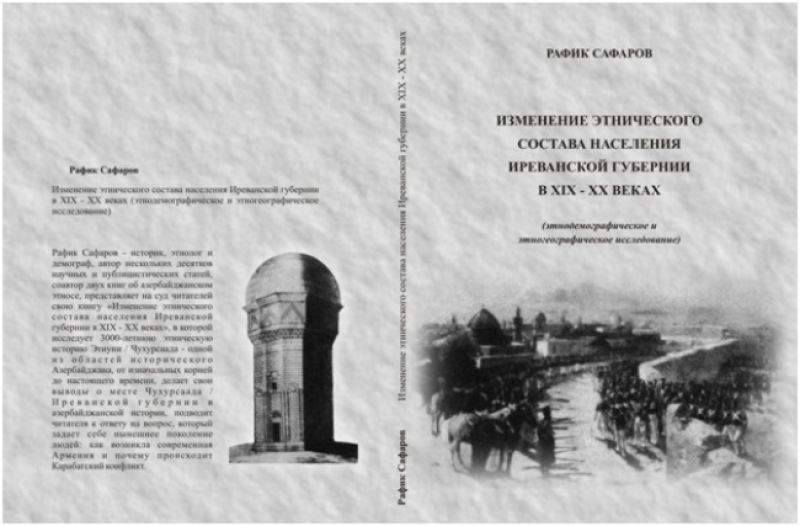
Panorama of the Azerbaijani city of Erevan during the surrender of the fortress to Russian troops on October 1, 1827. Artist Franz Roubaud
Mausoleum of the Chukhursaad emir Pir Hussein Saadli in the village of Jafarabad near Erevan (1st third of the 15th century)
Proceeding from on a number of reliable sources, new facts and evidence, the book puts forward a scientifically substantiated concept about the historical and ethno-political belonging of Chukhursaad (Erevan governorate) to Azerbaijan and the Azerbaijani people from ancient times to the present day. The book provides the first experience of research into the historical geography, ethnology, ethno-political history, ethnic demography and statistics of Chukhursaad. It also pays much attention to the ethnic composition, population migration, the ethno-political aspect of the Armenian colonization of the region and the genocide against Azerbaijanis in the Erevan province and on the territory of modern Armenia in the 19-20 centuries, their deportation and total exile.
Below-cited are some excerpts from this monograph.
Over the last 500-600 years the inseparable part of the Qizilbash state – Northern Azerbaijan was divided into Shirvan (center – Shamakhi), Karabakh (center – Ganja) and Chukhursaad (center – Erevan) vilayets. In the 50s of the 18 century the Karabakh khan seized the South Azerbaijani eyalet of Qapanat. Chukhursaad included the eyalets of Erevan, Nakhchivan and Eastern Shuragel. The Russian authorities added Pambak mahal from Upper Borchali to its composition, uniting it with Shuragel. In 1849 in place of Chukhursaad the Erevan governorate was formed within the same limits which existed until the Sovietization.
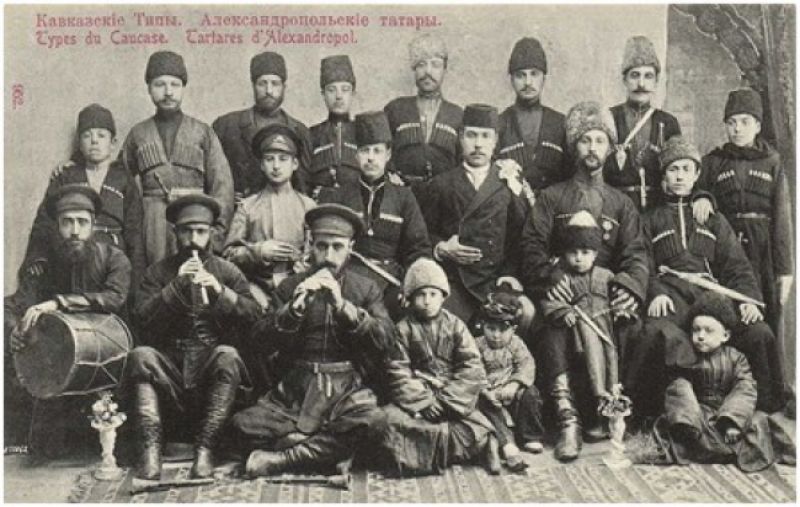
Shuragel: Azerbaijanis of Alexandropol (Gyumri)
It ought to be noted that the territorial composition of modern Armenia is somewhat different from Chukhursaad. With the help of the great powers, as well as Soviet Russia, the Armenian stronghold of the Russian Empire was artificially transformed into the Republic of Armenia, and then into the Armenian SSR. In 1918-1921 the Armenians gained most of the Erevan governorate, as well as parts of the former Karabakh (Upper Borchali (Lori) and Upper Qazakh-Shamshadil) and Qapanat. This stronghold consisted of the following Azerbaijani territories according to the Russian administrative division: Alexandropol (Pambak-Shuragel), Echmiadzin, Novobayazid, Erevan counties (except for Sadarak), Daralagaz section of Sharur-Daralagaz uyezd and Mavaz-i Khatun mahal (since 1928.) of Nakhchivan region of Erevan governorate, the west part of Zangezur (Qapanat-Zangezur) and the southern part of Qazakh counties of Ganja governorate, Lori district of Borchali county of Tiflis governorate and Aghbaba district (West Shuragel mahal) of Kars region.
Added to this can be that the borders of present-day Armenia unite lands that had never before formed a geographic, political, or even an administrative whole. During the formation of the Armenian SSR, the Azerbaijanis of the historical Chukhursaad were added to the Azerbaijanis of the lands of historical Karabakh vilayet and Qapanat. Nevertheless, the territorial and demographic basis of modern Armenia was formed by the Chukhursaad lands and the Chukhursaad Azerbaijanis. At that, Azerbaijanis of the other lands are now considered to be Chukhursaad Azerbaijanis.
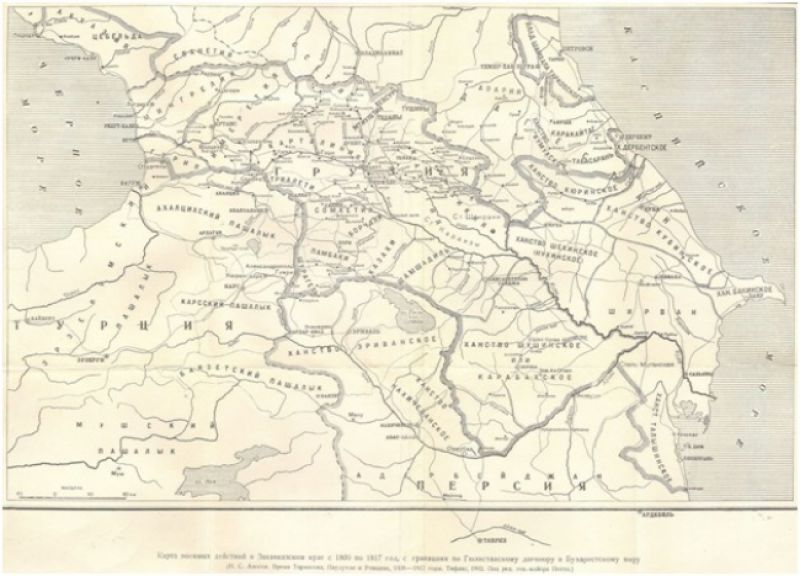
Map of the Transcaucasia in 1817 with borders under the Gulistan Treaty and the Peace of Bucharest
In this regard, we will consider the issues over Chukhursaad within the territorial framework of modern Armenia. However, first let us note that the population of Northern Azerbaijan in the first third of the 19 century was more than 1 million people. The Turkic-Muslim population was about 90%, including Azerbaijanis - 75% of the total population. According to historical and demographic analysis of the Ottoman census of 1724-1728, after the Ottoman-Qizilbash war (1723-1727) the number of Azerbaijanis decreased to 131,000 out of 171,000 total population of Chukhursaad. On the eve of the Russian conquest of Chukhursaad in 1826 there were 299,000 people, among which 188,200 (62.9%) were Azerbaijanis. During the years 1804-1813 up to 15,000 Azerbaijanis and Kurds from Qazakh-Shamshadil, Borchali, Ganja, and Karabakh migrated to the vilayet.
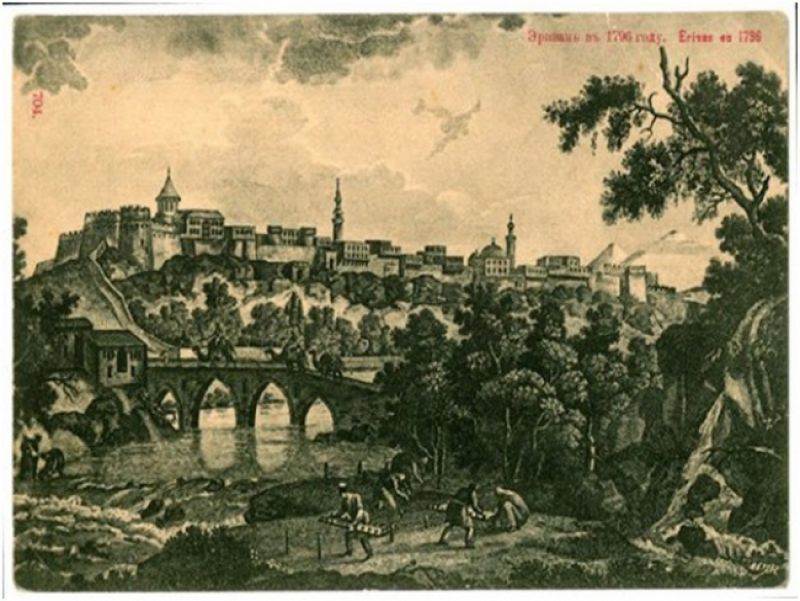
City of Erevan in 1796
The ethnic composition of the population of the territory of present-day Armenia in the 19-20 centuries was the same as in Chukhursaad. In 1826 there were 177,200 (69.2%) Muslim Azerbaijanis living on this territory including 158,200 (61.8%) Azerbaijanis out of 255,900 total population. Russia's policy of creating an Armenian outpost in the Caucasus by evicting Muslims and relocating Christians to their lands dramatically changed the ethno-demographic balance between the peoples. During the years 1801-1831 in Chukhursaad within the territorial framework of modern Armenia 10,000 Azerbaijanis were killed, 63,000 Muslims became refugees, including 16,000 Kurds. They mostly went to the Qizilbash state. The rest, namely 10,000 Azerbaijanis and 12,000 Kurds migrated to the Ottoman Empire (Kars and Bayazit). The Russian authorities resettled up to 134,000 Armenians and other Christians, as well as Yezidis in their places from the same countries.
According to Russian cameral descriptions of the provinces in 1829-1833, some 104,800 (32.4%) Azerbaijanis remained in the population of Chukhursaad, while the number of Armenians rose to 211,600. The population of Erevan city decreased to 12,000 people. Continuing its conquest policy, Russia in 1878, as a result of the war seized the regions of Kars and Batum from Turkey. During 1878-1882 years 98,000 Turks and Azerbaijanis left Kars region.
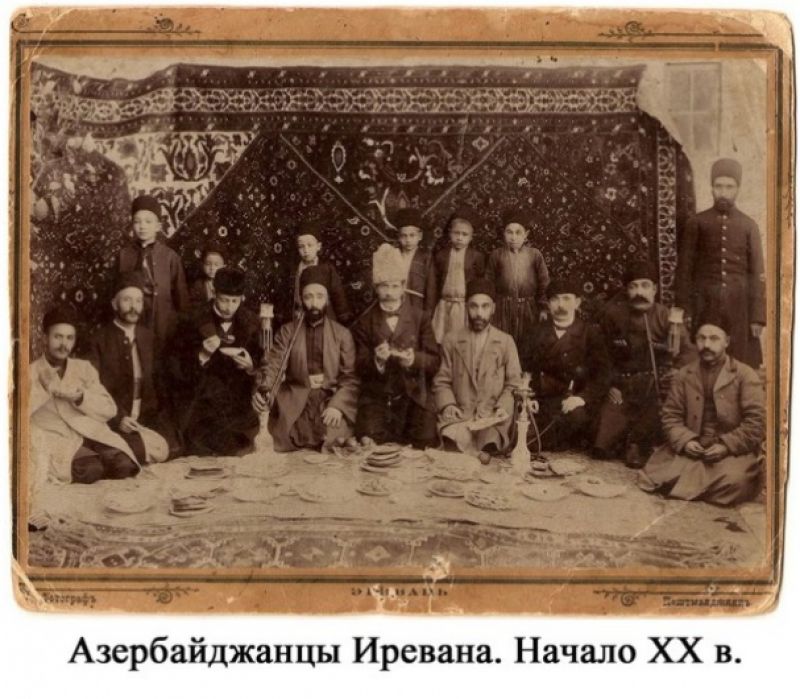
Azerbaijanis of Erevan. Early 20th century
According to the most accurate Russian census of 1897, there were 41,200 Azerbaijanis (a part of them were migrants from Chukhursaad) among 145,900 (50.2%) Muslims of the Kars region. On the eve of the First World War in 1914, the Azerbaijanis (1,992,000 people, including some smaller peoples) remained the largest ethnic and religious group among the population of the South Caucasus. The number of Chukhursaad Azerbaijanis grew during 1831-1914 to 270,400 people (27.6%). The number of Azerbaijani migrants in 1804-1828 to Ottoman Empire (10,000) and Qizilbash power (37,000) increased to 20,000 and 55,000 respectively. Total number of Chukhursaad Azerbaijanis was 345,400 people.
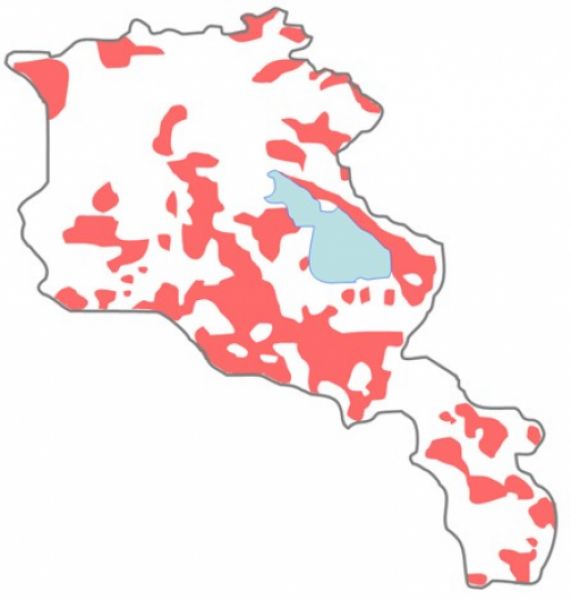
Azerbaijanis in Armenia according to the 1886 census
The prologue of the coming tragedy of Azerbaijan was the Armenian-Muslim massacre of 1905-1906. After the tragic period for Azerbaijan 1801-1831 the period of 1914-1921 – Turkic-Muslim genocide by Armenians and Bolsheviks is the greatest national tragedy. In December 1914 - February 1915 Russian punitive troops and Armenian military squads together with local Armenians committed genocide against the Turkic-Muslim population of Kars and Batum. In the Kars region, 31,000 Muslims, including Azerbaijanis, were brutally exterminated. At the end of 1917 there were 298,200 (23.5%) Muslims, including 282,800 (22.2%) Azerbaijanis in Chukhursaad. The fall of the Russian Empire and Bolshevik Russia's withdrawal from the war gave a free hand to Armenians who continued the genocide of Azerbaijanis in Kars and Erevan. Only in January-February 1918 in the Erevan governorate 211 Azerbaijani villages were razed to the ground and at least 27,000 people were exterminated, the rest became refugees. As a result of Armenian policy of ethnic cleansing and genocide, the number of Azerbaijani Muslims in 1919 decreased to 58,500, and by the time of Sovietization in the late 1920s, their number dropped to 10,000.
Some figures on the number of Muslim refugees from the Erevan governorate also testify to the enormous scale of the Armenian government's criminal deeds. According to official sources, by October 1919 up to 25,000 Muslims from Echmiadzin and Surmalu counties alone had massed up in Kars. According to official Azerbaijani data some 77,000 refugees from the territory of present-day Armenia were registered at the end of November, having received government assistance in Azerbaijan. Besides, there may have been some 16,000 unregistered refugees in Nakhchivan, the rest of Northern Azerbaijan, and Qizilbash State. The Chukhursaad lands were diligently cleared of Azerbaijani inhabitants by Armenians to create purely Armenian territories from which the Armenian state was formed.
The Moscow Treaty between Turkey and Russia and the Kars Treaty between Turkey and the three Republics of the South Caucasus, with Russian participation, concluded in 1921, helped to establish the state and Republican borders between these countries. It was only in the fall of 1921 that Azerbaijanis were permitted to return to their native lands now in Armenia / Chukhursaad. Of the nearly 108,000 refugees, only 74,000 returned by 1926, which was nearly 69% of the surviving Azerbaijanis forced to leave Armenia during the reign of the Dashnaks. Thus, out of 303,000 Chukhursaad Azerbaijanis who lived in Armenia and Kars on the eve of the separation of South Caucasus from Russia, during 1918-1920 no less than 180,000 people were killed because of the Armenian policy of genocide in respect of Azerbaijani Muslims. In total in 1914-1915 and 1918-1921 Armenians managed to annihilate 0.6 million Azerbaijani Muslims and cleaned 30,000 km2 of Azerbaijani lands from them.
As noted above, during the Sovietization, the territorial and demographic basis of modern Armenia consisted of four and a half counties of Erevan province. To these should be added the Azerbaijanis of Aghbaba, Sisyan and Qapanat. Before the Ottoman conquest of 1639, Aghbaba was an integral part of Chukhursaad, as was Kars until 1534. Sisyan mahal of Nakhchivan was also a part of Chukhursaad until the 1750s. Therefore, Azerbaijanis of Aghbaba and Sisyan are historical Chukhursaads. Azerbaijanis of the Armenian part of Qapanat (Kafan and Meghri) were also close to them. The rest of the Armenian Azerbaijanis from Qazakh-Shamshadil (Dilijan) and Lori were residents of the former Karabakh vilayet. Consequently, according to the 1922 census, 83% of the 77,800 Azerbaijanis of Armenia were natural Chukhursaads.
However, the well-forgotten Azerbaijani historical name of the entire region of Azerbaijan – Chukhursaad and its indigenous inhabitants – was replaced by the new concept of "Ermenistan" and "Ermenistanis" by the Chukhursaad people. In the 1990s, an inappropriate term for Chukhursaad – "West Azerbaijan" – was coined among some natives of Armenia without consultation with experts. Either they did not pay attention, or they were not aware of the existence of the name "West Azerbaijan" in historical Azerbaijan, more specifically in South Azerbaijan, which has been used for quite a long time to refer to the Iranian remnant – the former Urmia province. They have thus created historical-geographical, ethno-political and ethno-demographic confusion on all-Azerbaijani scale. Moreover, the very historical pronunciation of Chukhursaad has been subjected to distortion in Azerbaijani - Chukhursiaed, Chukhursiadd, Chukhursiad.
After the genocide, ethnic cleansing, and migration of Chukhursaad Azerbaijanis in Armenia, their settlement in 1926 looked like as follows: 90,600 in the Armenian SSR, 21,000 in Azerbaijan, 55,000 in Iran and 22,000 in Turkey, i.e. 189,000 people in total.
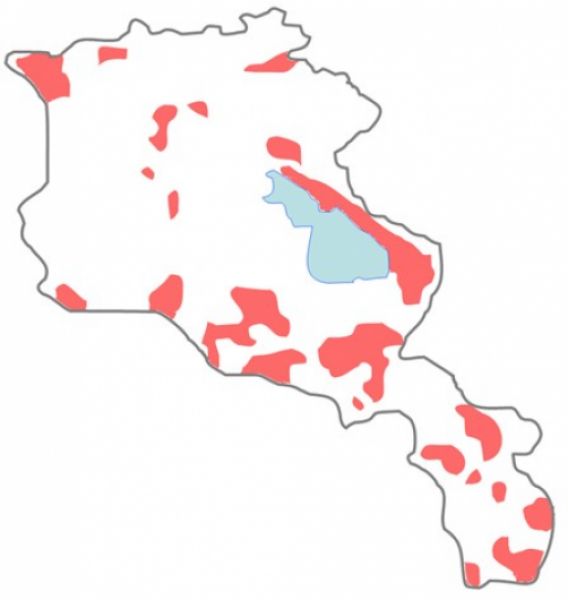
Azerbaijanis in Armenia according to the 1926 census
Note that the Azerbaijani population in Armenia rose to 130,900 (10.2%) in 1939, according to census data. About 25,000 Azerbaijanis from Armenia contributed to the victory of the USSR in the World War II. The number of Azerbaijanis in Armenia in 1946-1947 was about 110,000-115,000 people, or 9.7-10.2% of the population. The third tragic stage in the history of the Chukhursaad Azerbaijanis was looming.
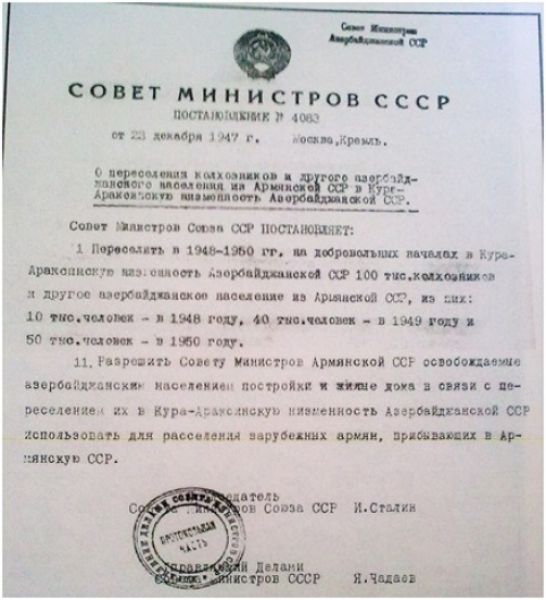
Stalin's 1947 decree on the resettlement of the local Azerbaijani population from the
Armenian SSR and the settlement of foreign Armenians on their lands and in their homes
Soviet plans for the annexation of Turkish territories placed Soviet Armenia in the most advantageous military and geographic position. The cleansing of Armenia from Azerbaijanis was a part of the plans to strengthen the Armenian bridgehead. The decree signed by Stalin on December 23, 1947 planned to move in 1948-1950 100,000 collective farmers and other Azerbaijani population from Armenia to Azerbaijan. The deportation process was stretched out and after Stalin's death the deportation decreased. According to the data of the Ministry of Agriculture of Azerbaijan dated October 14, 1954, 11,914 households (53,000 people) were moved from Armenia in 1948-1953. At the same time, about 40-45% of the surviving Azerbaijani evictees returned to their villages. This implies that at the end of 1953 there were 86,000 Azerbaijanis in Armenia, and about 29,000 new Armenian Azerbaijanis in Azerbaijan. Therefore, the census of 1959 recorded only 107,700 (6.1%) Azerbaijanis in Armenia.
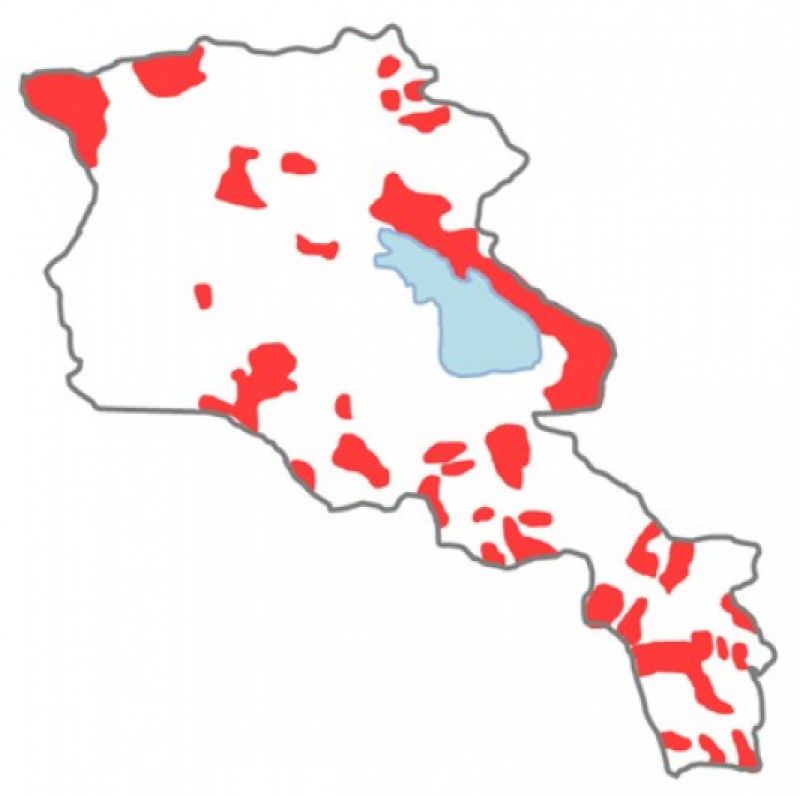
Azerbaijanis in the Armenian SSR according to the 1959 census
Undoubtedly, the aggressive and nationalistic policy of the Armenian authorities affected the dynamics of the number of Azerbaijanis. Since the second half of 1960s, their migration outside of Armenia increased. The census of 1979 counted only 161,800 (5.3%) Azerbaijanis. These trends influenced the growth of the number of Azerbaijanis by the end of the 1980s. At the beginning of 1988 it reached the maximum of 173,000-178,000 in Armenia and together with the Muslim Kurds – 175,000-180,000. 40 years later, in 1987 the fourth tragic stage began, and during 1987-1991, mainly in 1988, all the native Azerbaijani-Muslim population was expelled from Armenia (175,000-180,000 people).
The total number of Azerbaijani migrants from Armenia during 1927-1988 should be approximately 330,000 (deportees 1948-1953, migrants in 60-80s and refugees 1987-1991). In Azerbaijan the number of Chukhursaad Azerbaijanis (refugees from Armenia in 1918-1920) rose to 75,600 people. On the eve of collapse there were 406,000 Azerbaijanis living in USSR (actually all in AzSSR), 90,000 in Turkey, 259,000 in Iran. The total number of Chukhursaad Azerbaijanis in the world was 755,000. Today, the number of Chukhursaad Azerbaijanis in the world may reach 1.18 million, and, taking into account the potential migrants to the Arabian Peninsula, the West, etc., their number will be approximately 1.2 million people.
Over the past 220 years the Chukhursaad Azerbaijanis have experienced four tragic stages in the general course of national upheavals in the history of Northern Azerbaijan. They became victims of the Russian conquest and colonial policy, the genocide by the Armenians and the repression of the Communist regime. As a result, during this historical period, Chukhursaads lost hundreds of thousands of people.
Rafiq Safarov,
Ph.D. in History, Associate Professor
Leading Researcher of the Institute of Archaeology, Ethnography and Anthropology of the Azerbaijan National Academy of Sciences
Baku, September 29, 2022.































Leave a review